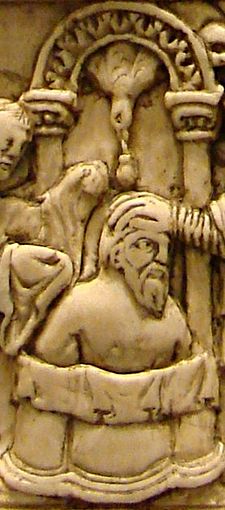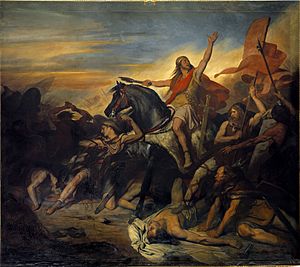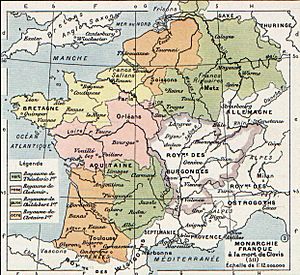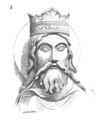Clovis I facts for kids
Quick facts for kids Clovis I |
|
|---|---|

Baptism of Clovis, ivory book cover, 9th century
|
|
| King of the Franks | |
| Reign | 509–511 |
| Successor | Clotaire I (Soissons) Childebert I (Paris) Chlodomer (Orléans) Theuderic I (Rheims) |
| King of the Salian Franks | |
| Reign | 481–509 |
| Predecessor | Childeric I |
| Born | 466 Tournai (Belgium) |
| Died | November 27, 511 (aged 44 or 45) Paris (France) |
| Burial | Originally St. Genevieve Church Now Saint-Denis Basilica |
| Spouse | Clotilde |
| Issue | Ingomer Chlodomer Childebert I Chlothar I Clotilde Theuderic I |
| Dynasty | Merovingian |
| Father | Childeric I |
| Mother | Basina of Thuringia |
| Religion | pre-Schism Catholicism |
Clovis I (born around 466 – died November 27, 511) was a very important king of the Franks. He was the first ruler to unite all the different Frankish tribes under one kingdom. This changed how the Franks were led, from many small chiefs to one powerful king. Clovis also made sure that his sons would inherit the throne, starting a new tradition.
He is known as the founder of the Merovingian dynasty. This family ruled the Frankish kingdom for about 200 years after him. Many people see Clovis as "the first king of what would become France."
Clovis became king of the Salian Franks in 481, after his father, Childeric I, passed away. He slowly expanded his kingdom from what is now the southern Netherlands all the way to northern France. In 486, he won the Battle of Soissons (486), which helped him take control of a large part of what was left of the Western Roman Empire in Gaul.
By the time he died in 511, Clovis had conquered many smaller Frankish kingdoms. He also defeated the Alemanni tribes in eastern Gaul and the Visigothic kingdom in the southwest. These victories made his kingdom much bigger and made his family a major power in Western Europe.
Clovis was born following a pagan religion. However, he later became interested in Christianity. He converted to Catholicism around 496, largely because of his wife, Clotilde. She was a Burgundian princess and a devout Catholic. She is even considered a saint today.

Clovis was baptized on Christmas Day in 508. His choice to become Catholic, unlike most other Germanic tribes who followed Arianism, led many Frankish people to convert as well.
Clovis and his wife were buried in the Abbey of St Genevieve in Paris. This church was originally called the Church of the Holy Apostles.
Contents
Early Life and Family
Clovis was the son of Childeric I, who was a Merovingian king of the Salian Franks. His mother was Basina, a princess from Thuringia. The Merovingian dynasty is named after an older ancestor, Merovich.
Clovis became king when he was only 15 years old, in 481. Historians know this because a writer named Gregory of Tours said the Battle of Tolbiac happened in Clovis's fifteenth year as king.
In the 400s, there were many small Frankish kingdoms. The Salian Franks were the first Frankish tribe allowed by the Romans to settle inside the Roman Empire. They first settled near the Rhine and Maas rivers. Later, they moved to Toxandria, which is now parts of the North Brabant province in the Netherlands and parts of Antwerp and Limburg in Belgium.
Clovis's father, Childeric I, was a relative of an earlier Frankish leader named Chlodio. Childeric was known for fighting alongside the Roman military in northern Gaul. In 463, he helped defeat the Visigoths in Orléans. Childeric died in 481 and was buried in Tournai. Clovis then became king.
Historians believe that both Childeric and Clovis were important military leaders for the Romans in the area of Belgica Secunda. The Franks from Tournai became very powerful, partly because they worked with the Roman general Aegidius.
After a powerful Roman general named Flavius Aetius died in 454, the Roman Empire's power in Gaul weakened. This led to the Visigoths and Burgundians fighting for control. The part of Gaul still under Roman control became a kingdom led by Syagrius, Aegidius's son.
Clovis's Reign: Expanding the Kingdom
Taking Control of Gaul (481–491)
When Clovis became king in 481, he was only 16 years old. He probably had about 500 warriors. In 486, he decided to expand his kingdom. He teamed up with his relatives, Ragnachar from Cambrai, and another Frankish leader named Chalaric.
Together, these three leaders marched against Syagrius, the Roman commander, at Soissons. During the battle, Chalaric betrayed Clovis by not fighting. But even with this betrayal, the Franks won a big victory. Syagrius had to run away. This battle is seen as the end of Roman rule in Gaul outside of Italy. After the battle, Clovis took over Chalaric's land and captured him and his son.
At first, Clovis did not have the support of the Christian church leaders in Gaul. He even took things from churches. But the Bishop of Reims asked Clovis to return what was taken from his church. Clovis wanted to have good relationships with the church, so he returned a valuable item.
Some Roman cities did not want to surrender to the Franks. Verdun gave up after a short fight. Paris, however, resisted for several years. Clovis later made Paris his capital city. He also built a church there.
Clovis realized he needed the church's help to rule Gaul. So, he married a Christian woman named Clotilde. He also added many of Syagrius's soldiers to his own army. By 491, Clovis likely controlled the former Roman kingdom. In the same year, he successfully fought against a small group of Thuringians in eastern Gaul.
Alliances and Battles (492–506)
Around 493 AD, Clovis made an important alliance with the Ostrogoths. He arranged for his sister, Audofleda, to marry their king, Theodoric the Great.
In the same year, a nearby king, King of the Burgundians, was killed by his brother, Gundobad. This caused problems in that kingdom. Gundobad also killed his sister-in-law and forced his niece into a convent. Another niece, Clotilde, escaped to the court of Gundobad's other brother, Godegisel. Godegisel decided to become allies with Clovis and arranged for Clovis to marry Clotilde.
In 496, the Alamanni invaded, and some Frankish leaders joined their side. Clovis met his enemies near the strong fort of Tolbiac. The Franks suffered heavy losses during the fight. Clovis, along with many of his Frankish companions, may have converted to Christianity around this time. With the help of other Franks, he barely defeated the Alamanni in the Battle of Tolbiac in 496. After becoming Christian, Clovis sent his prisoners, Chararic and his son, to a monastery.
Around 500 or 501, Godegisel started plotting against his brother Gundobad. He promised Clovis land and money if Clovis helped him defeat Gundobad. Clovis wanted to remove any threats to his kingdom, so he entered Burgundian territory. Gundobad then moved against Clovis and asked his brother Godegisel for help. The three armies met near Dijon. Both the Franks and Godegisel's forces defeated Gundobad, who escaped to Avignon. Clovis followed him and surrounded the city. After a few months, Clovis agreed to stop the siege in exchange for yearly payments from Gundobad.
In 501, 502, or 503, Clovis led his troops to Armorica. He had only done small raids there before, but now he wanted to take full control. Clovis could not achieve this by fighting alone. So, he used diplomacy instead. This worked well because the people of Armorica also disliked the Arian Visigoths. So, Armorica and its fighters joined the Frankish kingdom.
Final Conquests (507–511)
In 507, Clovis's nobles allowed him to invade the remaining kingdom of the Visigoths. The Visigothic king, Alaric, had tried to be friendly with Clovis before. But Clovis could no longer resist attacking the Visigoths. Many Catholic Christians living under Visigothic rule were unhappy and asked Clovis for help. To make sure these Christians stayed loyal, Clovis told his soldiers not to raid or steal. He said this was not an invasion, but a liberation.
The Armonici people helped Clovis defeat the Visigothic kingdom of Toulouse in the Battle of Vouillé in 507. This battle ended Visigothic power in Gaul. It added most of Aquitaine to Clovis's kingdom and resulted in the death of the Visigothic king Alaric II.
According to a historian named Gregory of Tours, the Byzantine Emperor Anastasius I made Clovis an honorary consul after the battle. This was a high Roman title.
After the Battle of Vouillé in 507, Clovis heard that Chararic, whom he had imprisoned in a monastery, planned to escape. Clovis had him killed.
In the same year, Clovis convinced Prince Chlodoric to murder his own father. After the murder, Clovis betrayed Chlodoric and had his own messengers kill him.
In 509, Clovis visited his old ally, Ragnachar, in Cambrai. After Clovis converted to Christianity, many of his pagan followers had gone to Ragnachar's side. This made Ragnachar a threat to Clovis. Ragnachar refused to let Clovis enter his city. So, Clovis bribed Ragnachar's followers. Soon, Ragnachar and his brother, Ricchar, were captured and executed.
Death and Legacy

Shortly before he died, Clovis called a meeting of bishops from Gaul in Orléans. The goal was to improve the Church and create a strong connection between the king and the Catholic bishops. This meeting was called the First Council of Orléans. Thirty-three bishops attended and passed 31 rules about people's duties, the right to seek safety in churches, and church rules. These rules applied to both Franks and Romans, making them equal for the first time.
Clovis I is traditionally said to have died on November 27, 511. However, some records suggest he might have been alive until 513. So, the exact date of his death is not fully known. After his death, Clovis was buried in the Abbey of St Genevieve in Paris. His remains were later moved to Saint Denis Basilica in the 1700s.
When Clovis died, his kingdom was divided among his four sons: Theuderic, Chlodomer, Childebert, and Clotaire. This division created new kingdoms like Rheims, Orléans, Paris, and Soissons. This started a tradition of dividing the kingdom, which led to disunity until the end of the Merovingian dynasty in 751.
Clovis was a king without a fixed capital city or a central government beyond his own group of advisors. By choosing to be buried in Paris, Clovis gave the city special importance. When his grandsons divided the kingdom 50 years after his death, Paris was kept as a shared property and a lasting symbol of the dynasty.
The disunity continued even under the Carolingians. After a short period of unity under Charlemagne, the Franks split into different cultural areas. These later became the Kingdom of France, many German States, and the semi-independent kingdoms of Burgundy and Lotharingia.
Clovis's Impact
Clovis's conquests created a Frankish kingdom that included most of Roman Gaul and parts of western Germany. This kingdom lasted long after his death. To the French people, he is seen as the founder of France.
By converting to Christianity, he became an ally and protector of the Pope and the people, who were mostly Catholics.
Images for kids
-
Tomb of Clovis I at the Basilica of St Denis in Saint Denis
-
Battle of Tolbiac. Fresco at the Panthéon (Paris) by Joseph Blanc, circa 1881
-
Statue depicting the baptism of Clovis by Saint Remigius
-
Clovis statue at the Abbey Church of Saint-Denis
See also
 In Spanish: Clodoveo I para niños
In Spanish: Clodoveo I para niños








